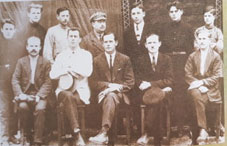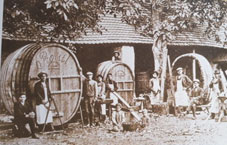
Emanuel Almendinger - Country of Liquid Sun
Monday, May 18
The German community was one of the most interesting, cohesive and well-to-do parts of Georgian society of the nineteenth to twentieth centuries, It is a well known fact that many prominent German figures contributed to the development of Georgia and the promotion of the country's culture in Europe. On Ekaterine II's instruction, German scientists travelled throughout the Caucasus and were commissioned to study the region and submit a report on economic situation to government officials.
It was the practice of Russian higher-ups to spread the opinion far and wide that Caucasians, including Georgians, were completely incapable of reforming the agriculture industry and its branches because of their "laziness," "negligence" and "lack of talent." The Russian government officially announced that favourable conditions were to be created in the Caucasus for German colonists to live and take care of the region's agricultural development.
The settlements and farms which were created by the German colonists in Georgia are still considered as exemplary countrywide. The strength of the German community was based upon the three main fundaments; namely, church, school and community associations.
Shortly after being settled in Georgia, the best land proved to be at the disposal of the German colonists. They sowed the land, grew vegetables and bred cattle but they were most interested in grape growing and wine making. They achieved a certain success with their vineyards and wine which sold well on the Tbilisi market due to its inexpensive price and satisfactory quality.
Together with a diligent work ethic, the German colonists also followed an active social life. A number of social associations functioned in the German settlements at the end of the nineteenth and beginning of the twentieth centuries such as trade unions, vine- growers' association and other associations which were created upon the basis of the members social-cultural interests such as bicycling clubs, stage companies and singing clubs, amongst others, as well as community-focused associations such as firemen's brigade and hunters' association with the tatter not only catering to the colonists' love of hunting but also having the function of protecting property and cattle from thieves.
The German colonies in Georgia were built according to certain rules: that is, with European-type stone houses, pebbled roads and fenced trees. Various workshops were located on the ground floors of the buildings such as barrel making, turning and carpentry shops, amongst others. Colonies typically had a church, pharmacy, school and a hotel.
Several foreign entrepreneurs worked in Georgia during the second half of the nineteenth century and beginning of the twentieth century with many having their own farms and enterprises. Prominent amongst them was the German colonist, Emanuel Almendinger.
In 1908, two cognac factories were opened in the German colony of Helenendorf located in the Borchalo province of the Tbilisi region. One of them belonged to Emanuel Almendinger and the other to the association of German colonists the Union,"Union.". The products which were manufactured by both of the German factories were inferior beyond compare in terms of their quality and or the scale of production as compared trade operations even with the to the larger products of the larger companies operating working at that time such as , for example, the Sarajshvili factory. However, the German manufactures are still worth mentioning, -with their production, certainly, deserving attention.
Almendinger's cognac factory had its own vineyards planted with Georgian grape varieties. Putting the factory into operation was conditioned by the abundant grape harvests in the 1900s and the decrease of wine prices. These facts allowed Almendinger to put launch his wine and cognac enterprises in the German colony of Ekaterinenfeld, located in the Boinisi region. At that time, a bucket of grapes cost only 60 copecks. High-quality wine materials were used for spirit distillation and, upon the basis of the produced spirit, in addition to cognac, they also made fortified wines. The fortified wines, which they called Madera, were made by the Germans according to special technology and sold at Tbilisi trade facilities. The colonists made the barrels, in which they aged the spirits for cognac, by their own efforts. In addition to Tbilisi and other Georgian cities, the production of Almendinger's factories was exported to various Caucausian cities and was successfully sold.
Georgian grape harvests decreased between 1909 and 1910 which sent wine prices up and reduced cognac production. In 1914, due to World War I, the sale of spirit drinks was prohibited with spirits only able to be used for medicinal purposes. Almendinger's factory found it difficult to remain in operation between 1914-1917 and was finally closed in 1916 with the arrival of the Bolsheviks.
In 1941 and following Stalin's order, a great tragedy befell the German settlements in Georgia when the colonists and their families were evicted and sent in exile to Siberia and Kazakhstan. Only a few-those who had non- German spouses- escaped persecution. The farms which had been established by the German colonists were ultimately destroyed but the traces of their culture can still be noticed in various regions of Georgia.






